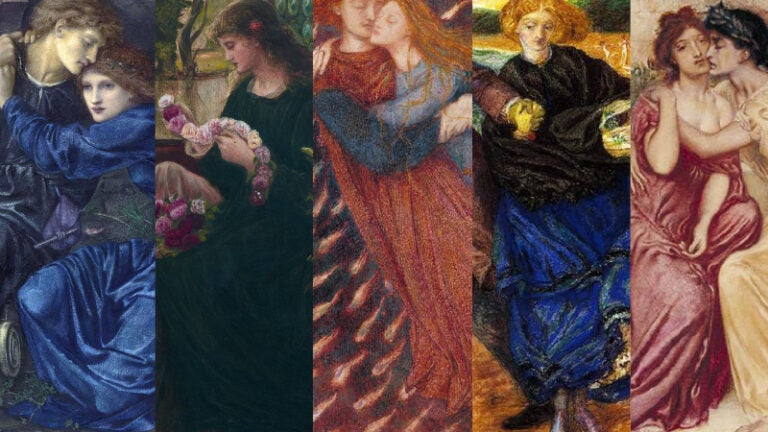
5 Victorian paintings that break tradition in their celebration of love
The modern Valentine card was born in Victorian England. Cheaper paper and printing methods — as well as new techniques for cutting paper into hearts and other decorative shapes — led to the rise in the profitable commercial enterprise that remains to this day.
Kate Flint, Provost Professor of Art History and English at USC Dornsife, studies 19th-century British art, literature and cultural history. Considering the cultural tides of the era, it’s not a surprise that this period gave rise to the Valentine, she says. In Britain, and increasingly in the U.S. and Europe, there was more weight put on marriages based on love and companionship, as opposed to convenience, strategic alliances or money. “That’s something that spills over into literature and that spills over into art,” Flint said.
In honor of Valentine’s Day, Flint selected five paintings from the Victorian period that embody this cultural shift. While many paintings of the time depicted clichéd gender roles — “a strong, upright, handsome young man with a woman adoringly gazing up to him,” she said — many harken back to classical or medieval times, when artwork tended to exhibit more reciprocal passion.
“That was what was really interested me — works that celebrate mutuality, passion, care and also reciprocity,” she said. “Love as it was in the moment and not with an eye to the future of the family.”
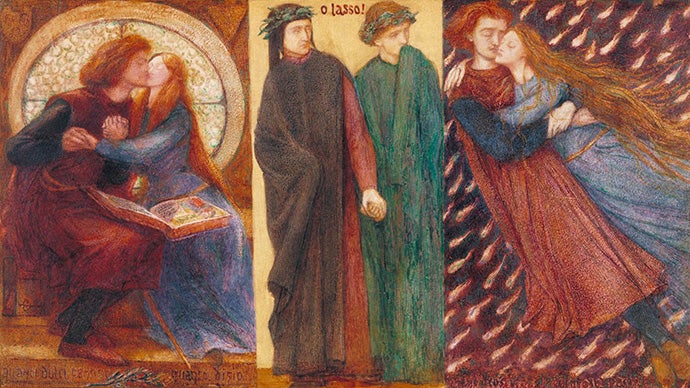
1. “Paolo and Francesca da Rimini” (1855) by Dante Gabriel Rossetti
This triptych depicts the story of adulterous lovers Paolo and Francesca, which originates from Canto V of Dante’s Inferno. In the left panel, Paolo and Francesca are reading one of literature’s most powerful pieces of illicit love — the romance between Lancelot and Guinevere at King Arthur’s Court, a scene that plays on Victorian’s anxieties about the corrupting power of reading, said Flint.
“Their ecstasy is beautifully set off by the horrified looks on Dante and Virgil’s faces in the center panel. They have to hang on to each other in a kind of distressed friendship to cope with what they’re witnessing.”
In the final scene on the right, the lovers are shown banished to the second circle of hell.
“But actually, despite all of the flames going past them like little tadpoles, they look like angels,” Flint said. “They’re just in each other’s arms, they’re swooning with happiness, and however much they’re going to be singed by fire, they cannot resist each other. They’re — as far as one can see —extraordinarily happy. For now.”
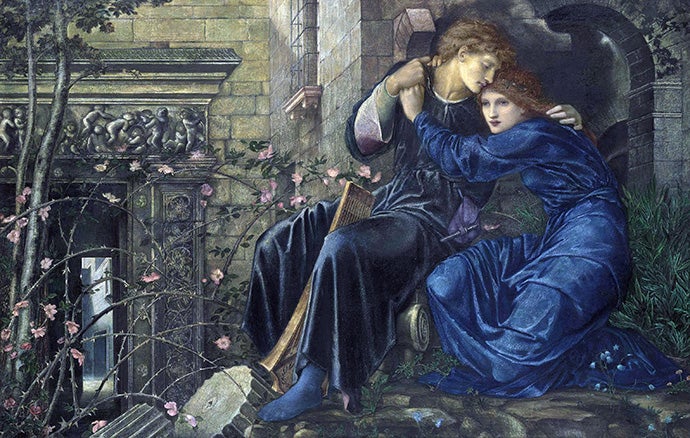
2. Love Among the Ruins (1894) by Edward Burne-Jones
The viewer is left to invent the story of the image, but there are clues beyond the title that suggest a post-apocalyptic setting, said Flint.
“We don’t know anything about what looks like an abandoned palace. There’s fallen masonry in the foreground. There are these beautiful brown roses, which appear to be taking over the previous building as though they’ve escaped from the garden,” she said.
While the arrangement of the lovers in this portrait is more conventional — a young man and a young woman clinging to each other — the woman has a strength in her gaze, Flint said.
“Although the man may be looking down at her with love and adoration, and she’s looking out more dreamily and more speculatively into a completely unknown future, she’s not looking out weakly. She looks to me like she’s trying to figure out, ‘What do we do next?’”
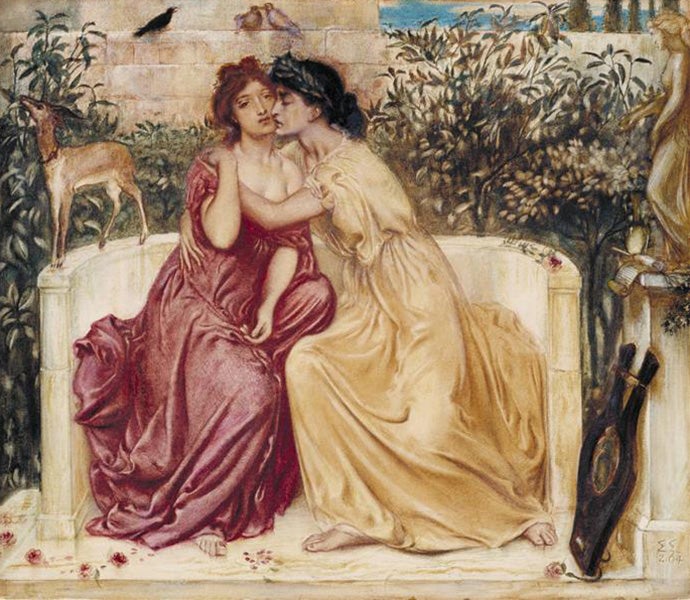
3. Sappho and Erinna in a Garden at Mytilene (1864) by Simeon Solomon
In this painting, Simeon Solomon depicts passion between Erinna and Sappho, two female poets in ancient Greece. Sappho, whose works are associated with love between women, fascinated Victorian writers and scholars as fragments of her poetry were discovered and translated.
In the painting, Sappho embraces Erinna. We’re unsure if the feeling is mutual, Flint said, but the rose petal on her foot, which she hasn’t bothered to flick away, may mean she is wrapped up in the moment. A lyre and a scroll off to the side suggests that Sappho might be writing Erinna a poem or about to sing her a song.
But the most telling clues that this love may be unconventional or dangerous, Flint explained, are the birds in the background. A pair of turtle doves behind the two women suggests they are billing and cooing to each other. But on the left-hand side there’s a crow mocking them.
“I think it’s ominous, jeering at them — whatever is going on suggests that they’re either going to be mocked or under threat from outside,” Flint said.
With this painting, Solomon, who suffered persecution and discrimination because of his homosexuality, is bringing same-sex love into the public domain of a gallery or an exhibition wall, explained Flint.
“He appears to be speaking for desires and relationships that proliferated in Victorian Britain, but were not spoken about overtly.”
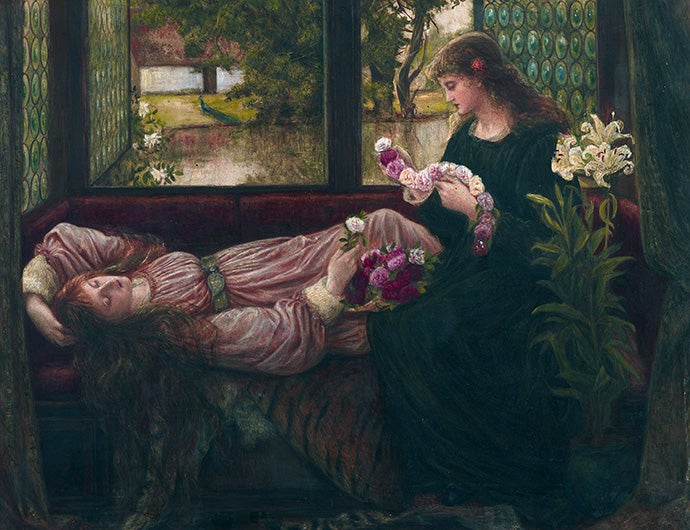
4. A Wreath of Roses (1880) by Marie Spartali Stillman
Many of the paintings on this list are trying to suspend time and play with 19th-century audiences’ expectations of viewing a story. A Wreath of Roses is no different. However, we’re not quite sure what the story is here, Flint said.
We can only guess what the relationship is between the two women. “It may be two women in what the Victorian’s would have termed a ‘romantic friendship’ or perhaps two sisters — Stillman often used her daughter and two step daughters as models in her work.”
Above all, it appears to be about a romantic atmosphere.
“It looks like a beautiful summer day outside. There are roses and lilies, which are conventional symbols of love and passion. But the romance lies within the feeling of contentment, unquestioning satisfaction, pleasure and sort of sense of completion in each other’s presence.”
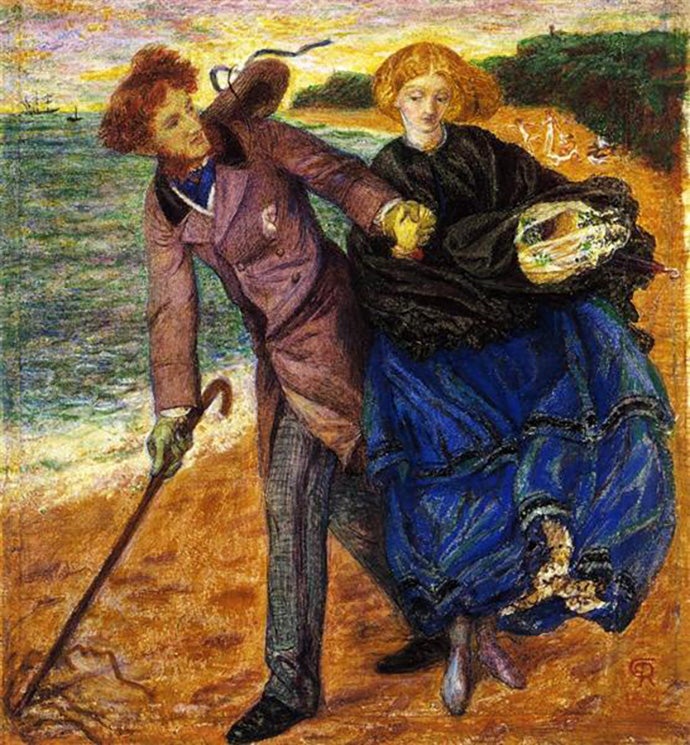
5. Writing on the Sand (1859) by Dante Gabriel Rossetti
Historically, some critics have read this painting as depicting a possible separation between the two lovers. The man looks to be drawing the woman’s portrait in the sand, recalling the famous poem by Edmund Spenser that begins: “One day I wrote her name upon the strand, but came the waves and washed it all away.”
“On the one hand, the poem is saying you can’t hold love still. Time washes away everything,” said Flint. “But the very fact of writing about love in a sonnet or capturing it in a painting immortalizes it.”
The scene that Rossetti creates breaks from the convention of lovers gazing at each other in an enclosed space. “Instead, we have a celebration of love that takes place out in the world going for a walk along the beach,” said Flint.
She interprets it as a happy picture: “They appear to be tripping happily along the sand together.”